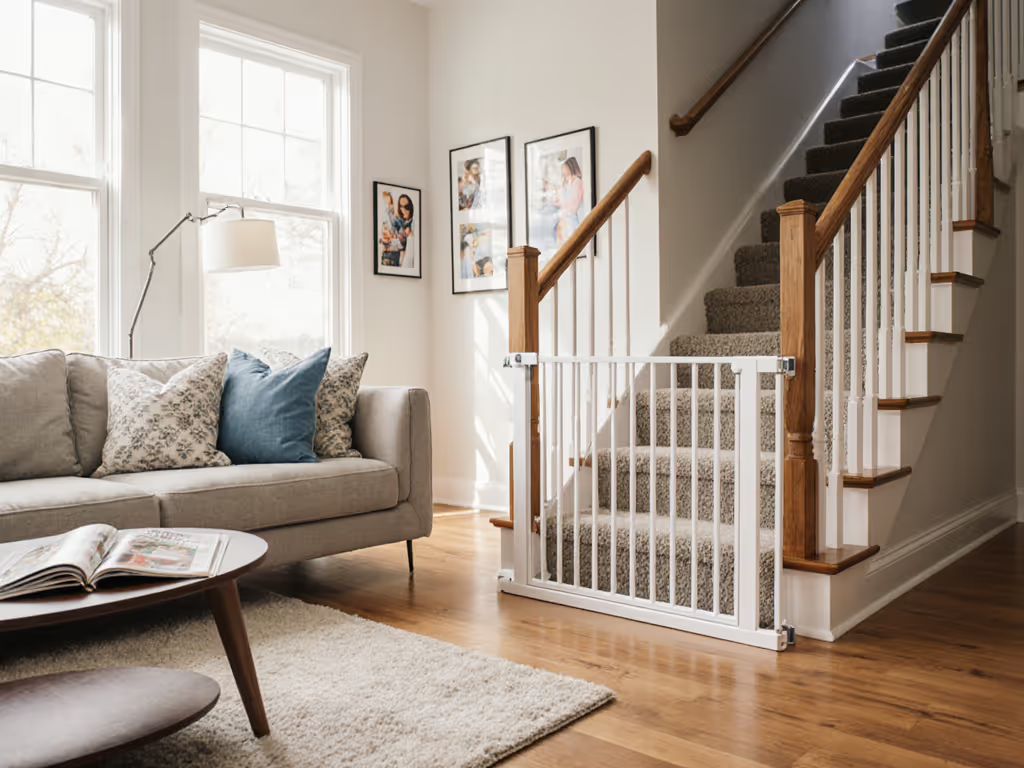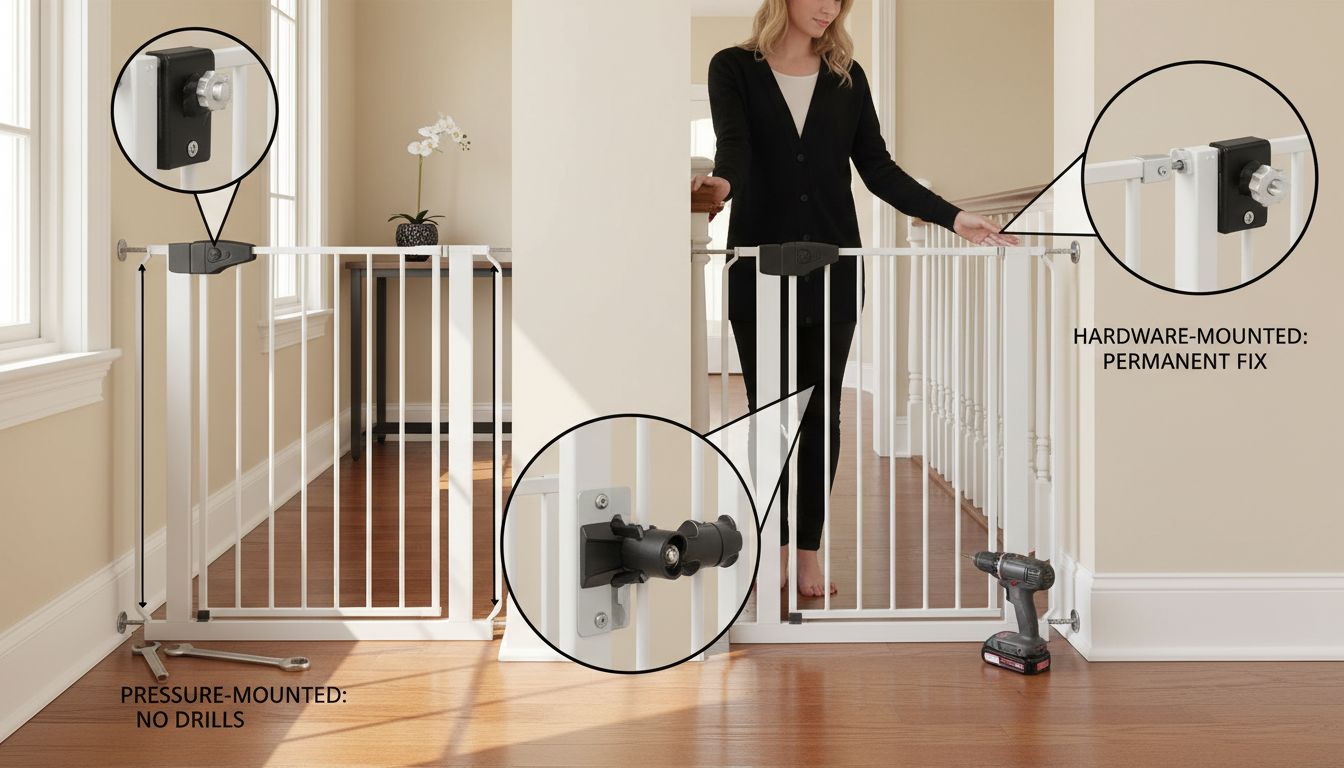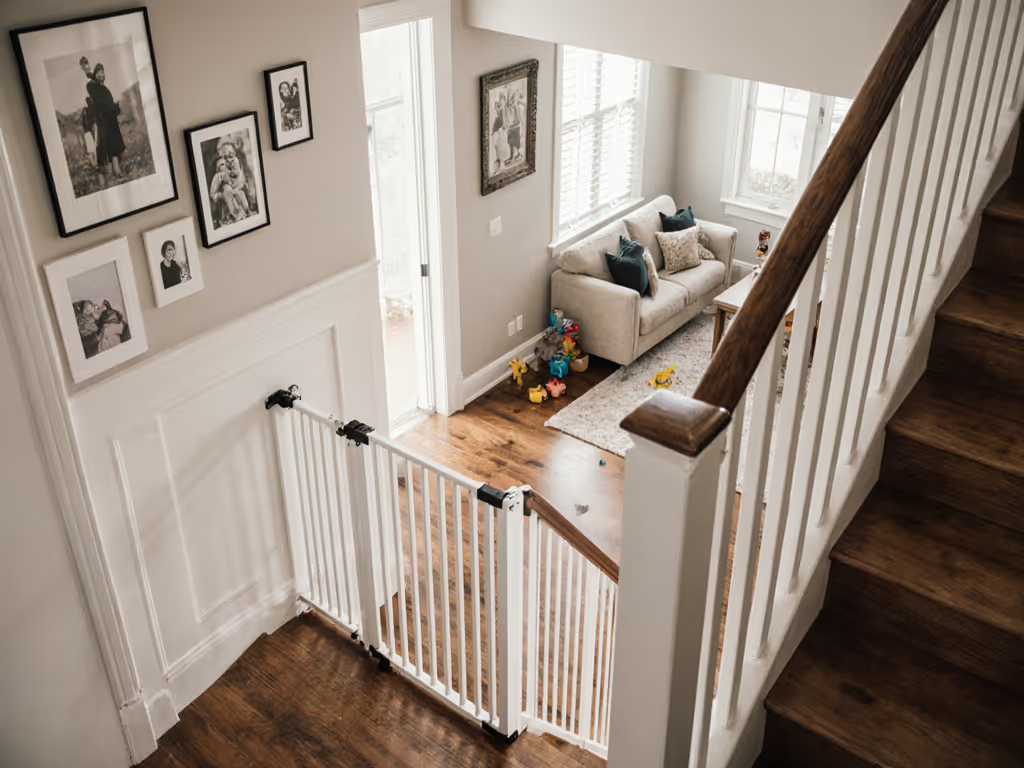
Complete Guide to Gates for Wide Staircases

Did you know that falls are the leading cause of nonfatal injuries for children under five, with over one million incidents each year in the United States alone? Protecting curious kids from wide staircases takes more than a basic gate, especially as modern homes often feature expansive or irregular designs. Knowing what makes a gate truly effective for wider spaces gives you the confidence to create a safer home and meet your family's unique needs.
Key Takeaways
| Point | Details |
|---|---|
| Safety is Paramount | Stair gates serve as critical barriers to prevent young children from accessing dangerous areas like staircases. |
| Wide Staircase Gates | These gates are designed to fit openings from 29 to 57 inches, addressing unique home layouts and providing secure access control. |
| Installation Methods | Gates can be pressure-mounted for temporary needs or hardware-mounted for permanent placements, each offering distinct advantages. |
| Compliance with Standards | It's essential to choose gates that meet international safety regulations, ensuring they are robust and secure for use in homes with children. |
Defining Gates for Wide Staircases
When it comes to home safety, stair gates are more than just simple barriers. They're your first line of defense in protecting curious little explorers from potential hazards. These specialized safety devices are strategically designed to block access to areas like staircases, preventing young children from accidentally tumbling down steps or wandering into potentially dangerous zones.
A wide staircase gate is specifically engineered to address unique home layout challenges. Unlike standard narrow doorway gates, these solutions are constructed to span broader spaces safely and securely. Typically made from durable materials like metal, wood, or high-grade plastics, these gates can extend to cover wider openings ranging from 29 to 57 inches, ensuring comprehensive protection for non-standard architectural spaces.
Key Characteristics of Wide Staircase Gates
- Expandable width mechanisms for custom fitting
- Sturdy mounting hardware for secure installation
- Multiple attachment options (pressure mount or screw-in)
- Materials resistant to child tampering
- Designed to withstand repeated use and potential pushing/pulling
From a technical perspective, wide staircase gates come in two primary installation types: pressure-mounted and hardware-mounted (screw-fit) gates. Pressure-mounted gates use tension to grip wall surfaces, offering flexible placement. Hardware-mounted gates, by contrast, provide maximum stability by being directly screwed into wall structures, making them ideal for staircases where a more permanent and robust solution is required.
Choosing the right gate involves carefully measuring your specific staircase width and understanding your home's unique architectural features. While one-size-fits-all solutions might seem convenient, a precise fit ensures both safety and functionality. Consider factors like wall material, staircase angle, and potential obstructions when selecting your ideal wide staircase gate.

Types of Gates Suitable for Wide Staircases
When tackling the challenge of child safety on wide staircases, homeowners have several gate configuration options that provide both protection and flexibility. Not all safety gates are created equal, especially when dealing with non-standard architectural spaces that require more nuanced solutions. Understanding the different types of gates can help you select the most appropriate barrier for your specific home layout.
Here's a comparative overview of gate types for wide staircases:
| Gate Type | Installation Method | Best For | Key Advantages |
|---|---|---|---|
| Pressure-Mounted | Tension (no drilling) | Temporary/rental homes<br>Minimal structural changes | Easy setup<br>No wall damage<br>Portable |
| Hardware-Mounted | Screws/anchoring | Permanent installations<br>Complex/angled staircases | Maximum stability<br>High security |
| Flexible/Specialized | Multi-angle/adaptable systems | Irregular layouts<br>Curved or diagonal spaces | Fits unusual spaces<br>Multiple mounting options |

Pressure-Mounted Gates
Pressure-mounted gates represent the most versatile option for wide staircases. These gates use adjustable tension mechanisms to create a secure fit between walls or banister posts without requiring permanent installation. Key advantages include:
- Quick and easy installation
- No drilling or wall damage
- Easily removable and repositionable
- Suitable for temporary or rental spaces
- Ideal for spaces with minimal structural modifications
Hardware-Mounted Gates
For maximum stability and long-term safety, hardware-mounted gates offer the most robust solution. These gates are directly screwed into wall structures, providing an immovable barrier that can withstand significant pressure. They are particularly recommended for:
- Permanent home installations
- Staircases with challenging angles
- Homes with active or strong children
- Areas requiring maximum security
Specialized Flexible Gates
Innovative gate designs like the BabyDan Flexi Fit series represent a breakthrough for unconventional spaces. These gates feature unique installation systems that can be mounted inside, outside, or even diagonally across staircase openings. Their adaptable design addresses architectural challenges that traditional gates cannot, making them perfect for homes with irregular layouts or non-standard staircase configurations.
Selecting the right gate isn't just about width measurement. Consider your specific household dynamics, child's age and mobility, and long-term safety needs. A gate that works perfectly in one home might be completely unsuitable in another. Take time to assess your unique requirements and choose a solution that provides both comprehensive protection and practical functionality.
Key Features and Installation Requirements
When selecting a safety gate for wide staircases, understanding the critical installation features becomes paramount to ensuring both child safety and long-term functionality. The right gate isn't just about blocking a pathway—it's about creating a reliable barrier that can withstand curious toddlers and unpredictable household dynamics.
Material Considerations
The gate material plays a crucial role in durability and performance. Metal gates offer superior strength and longevity, while wooden gates provide aesthetic flexibility. Key material characteristics include:
- Resistance to child tampering
- Ability to withstand repeated stress
- Compatibility with different wall surfaces
- Corrosion and wear resistance
- Weight and structural integrity
Installation Options
Two primary installation methods demand careful consideration: pressure-mounted and hardware-mounted systems. Pressure-mounted gates use adjustable tension mechanisms, making them ideal for temporary or rental spaces. Hardware-mounted gates require permanent screws and provide maximum stability, especially critical for wide staircases with complex architectural layouts.
Essential Technical Specifications
Beyond basic installation, several technical specifications determine a gate's effectiveness:
- Width range (typically 63.5 cm to 106 cm)
- Quick-release fitting mechanisms
- One-handed operation capabilities
- Auto-close and auto-lock features
- Compatibility with various wall and banister materials
Professional installation isn't just recommended—it's essential. Even the most robust gate can fail if improperly mounted. Take precise measurements, understand your specific architectural constraints, and consider consulting a professional if you're uncertain about the installation process. Remember, a few extra minutes of careful preparation can prevent potential accidents and ensure your child's safety.
Safety Standards and Regulatory Compliance
Ensuring the safety of children around staircases goes far beyond selecting a visually appealing gate. Safety standards and regulatory compliance represent the critical backbone of protection, establishing minimum requirements that manufacturers must meet to protect vulnerable young explorers from potential accidents.
International Safety Regulations
The EN1930 standard serves as a comprehensive benchmark for indoor safety gate design, setting stringent guidelines for materials, construction, and performance. This international regulation requires gates to undergo rigorous testing to ensure they can withstand significant physical stress and prevent children from bypassing or damaging the barrier. Key compliance requirements include:
- Minimum strength testing for structural integrity
- Gap size limitations to prevent child entrapment
- Material toxicity and durability assessments
- Precise measurements for opening mechanisms
- Consistent performance under repeated use conditions
Critical Safety Mechanism Requirements
Modern safety gates must incorporate advanced design features that go beyond basic barrier functionality. Regulatory-approved gates typically include sophisticated mechanisms such as:
- Push and lift opening systems
- Soft-close shutting mechanisms
- Dual-action quick wall release features
- Automatic locking systems
- Child-resistant latching designs
Parents should always verify that potential gate purchases carry recognized safety certifications. Look for explicit markings indicating compliance with international standards like EN1930 or equivalent regional safety regulations. These certifications aren't just bureaucratic stamps—they represent carefully researched protections designed to keep children safe in potentially hazardous home environments.
Remember that no safety standard can replace active parental supervision. While these regulations provide critical baseline protections, they should be considered supplementary to—not a replacement for—attentive caregiving. Regular inspection of gates, understanding their limitations, and maintaining situational awareness remain the most important safety strategies for protecting children around staircases.
Common Challenges and Solutions for Wide Staircases
Navigating the complex world of safety gates for wide staircases can feel like solving an intricate puzzle. Architectural diversity presents unique challenges that standard gate solutions often struggle to address, requiring creative and flexible approaches to child safety.
Irregular Staircase Configurations
Wide staircases frequently come with unconventional architectural features that complicate gate installation. Challenging structural elements can include:
- Curved or angled staircase walls
- Inconsistent banister heights
- Uneven surface materials
- Significant width variations
- Architectural obstructions like decorative moldings
Flexible Installation Solutions
Innovative gate designs like the BabyDan Flexi Fit series represent breakthrough solutions for complicated spaces. These gates offer remarkable installation flexibility, allowing mounting:
- Inside staircase openings
- Outside wall perimeters
- Diagonally across unconventional spaces
- With adjustable tension mechanisms
- Across non-standard width ranges
Measurement and Adaptation Strategies
Successful gate installation requires a methodical approach. Homeowners should:
- Measure total staircase width at multiple points
- Assess wall and surface materials
- Identify potential mounting challenges
- Select gates with expandable width ranges
- Consider professional consultation for complex installations
Remember that no single gate solution works universally. Patience, careful measurement, and willingness to explore specialized products are key to finding the perfect safety barrier for your unique staircase configuration.
Find the Perfect Gate Solution for Your Wide Staircase
Wide staircases bring unique challenges when it comes to keeping your little one safe from dangerous falls and accidents. This guide covers important factors like gate width, installation types, and safety standards that are key to making the right choice. If you are struggling to find a secure and reliable safety gate that fits your non-standard staircase or irregular home layout, you are not alone. Many parents face the frustration of gates that don't fit well or lack essential safety features like hardware mounting or child-resistant locks.
Explore expert advice, detailed reviews, and tailored buying guides at https://babysafetygates.world. Our site helps you compare pressure-mounted and hardware-mounted gates, find flexible solutions like the BabyDan Flexi Fit, and understand compliance with safety standards including EN1930. Don't wait until an accident happens to secure your home. Visit Baby Safety Gates now to discover the perfect gate for your wide staircase and take the first step towards peace of mind and a safer environment for your child.
Frequently Asked Questions
What are the key characteristics of wide staircase gates?
Wide staircase gates are designed to cover broader spaces, typically ranging from 29 to 57 inches in width. Key characteristics include expandable width mechanisms, sturdy mounting hardware, child-resistant materials, and installation options such as pressure-mount or hardware-mount.
How do I choose the right gate for my wide staircase?
To choose the right gate, measure the staircase width carefully, consider the home's architectural features, and decide between pressure-mounted or hardware-mounted options. Also, assess your child's age and mobility to ensure the gate provides adequate safety.
What are the differences between pressure-mounted and hardware-mounted gates?
Pressure-mounted gates use tension to fit between walls without drilling, making them easy to install and relocate, ideal for temporary setups. Hardware-mounted gates require screws for installation, providing maximum stability and are suited for permanent use in high-traffic areas like staircases.
What safety standards should I consider when purchasing a staircase gate?
Look for gates that comply with international safety standards such as EN1930. These standards require tests for strength, gap sizes to prevent entrapment, and robust materials. Ensure the gate features child-resistant latches and effective locking mechanisms for enhanced safety.





